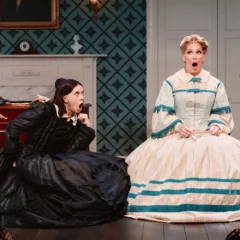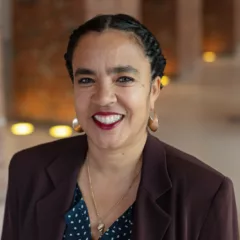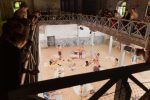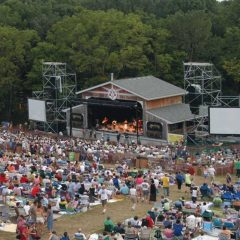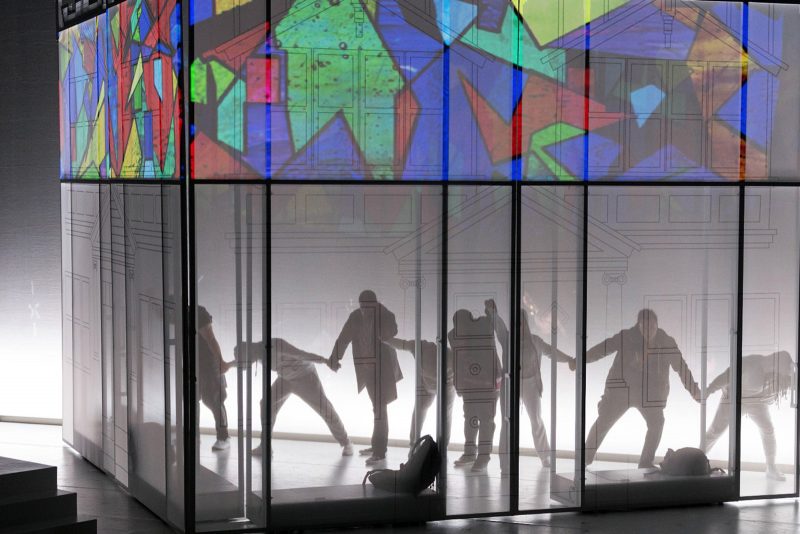
Opera Not Just for Old White Folks Anymore
by Lisa Anderson Bongers
Opera. Not just for old white people anymore.
Hip-Hopera. What does that even mean? It was some odd made up combination of words trying to make an 18th century (if you are being generous) art form sound relevant. Like it wasn’t an outdated, extravagant, over inflated misogynistic art form for the hyper very white elite. That was the mind set walking into WE SHALL NOT BE MOVED. (Presented by Opera Philadelphia)
First of all, it was odd to go into a small intimate space for an opera. Usually you can’t see an opera in a space smaller than 1000+ . The Wilma holds less than 500. There were other things that made this feel different from a regular opera. First of all, it was in your face. There was no orchestra pit between you and the singers. You could actually put your foot on the stage and would be less than 1’ from the artists. Close enough for them to sweat on you. Close enough that you could actually see their facial expressions. (gasp!) The orchestra was behind the singers and instead of 60 strings the orchestra had electric instruments and a drum trap set as well as traditional instruments. There was no big red velvet curtain, and the audience wasn’t all over 50 year old white people. They were all over the map– black, brown, white young and old. Then the music started.
A very haunting dissonant vocal line erupted into performers waking past you in the audience to the stage keeping that “in your face” style going. Didn’t these people know anything about opera? It was supposed to be remote and presented behind a picture frame. Remote and removed from anybody’s life. They were dancing! Not the folk dances or ballet of the opera but fantastic modern dance. Not Martha Graham modern dance but dance people want to see today-like Beyonce dancers and something more. And the singing. There was one singer who sang like Michael Jackson or Prince but different maybe with a bit of Mahalia Jackson thrown in. How could they make a counter tenor sound so new? The music was a little bit hip-hop, a little bit of gospel, some ballad some classical and some spoken word. It managed to be a little bit of everything all at the same time.
The story was unbelievable. But on closer examination you had to believe. It was real. I had just moved to Philadelphia and it wasn’t something I knew about, but a Google search at intermission proved that it was true. How did the world not know that Philadelphia police had dropped a BOMB on its own people? But it wasn’t just about that. It was also about now. It was about not only being invisible in Philadelphia, but being invisible everywhere. When you don’t have a family you make your own. When being black is not only about your skin color but about being not important, not in the light, not good. There was a character that had white skin but identified as black and it made you think beyond skin color for the word. When what you are physically is not prized by the world. Whether it is the color of your skin or the body that isn’t “right by them”. “This is my Body” was a question of “what is wrong with me?”. It was about not belonging, but finding a way to belong within a family of your own making. It was an anthem of inclusion that was presented in the vernacular of the common man. Spoken word, dance, insecurity, bravado, and pain.
Art can be relevant. Opera can be relevant. Both can let you escape, but also both can help you understand what is happening in the world around you. Opera was supposed to be the meeting of all of
the arts. Then it got dusty and became a museum piece. I think art should make you feel something. The death of art is when you see or hear something and your main thought is-“hmmm, where should we go for drinks after this?”
This was the meeting of the arts today. Visually the artwork projected onto the ever changing scenery was brilliant, the poetry of the spoken word and the lyrics made you think and cry. The dancing was as amazing as only Bill T Jones of the Alvin Ailey dancers, and the Bill T Jones project could make it. And the music– the music did exactly what it was supposed to do. Where words can’t go, the music takes you. Sometimes words aren’t enough to express the anger or the loneliness, but Daniel Romaine found the notes to say it.
It was very Philly style. In your face. Philadelphia has its own version of acceptance, but they do have a form. San Francisco is live and let be (or at least it used to be), New Orleans is “laissez les bonne temps roulez” and Philly is “this is me. You got a problem with it?” It may not have been the art form for every classical opera lover, but in Philly style “This is it. Gotta problem?”
Bio
Lisa Bongers recently moved to Philadelphia with her husband, dog and cat, after living all over the country, most recently San Francisco. Loving Philadelphia and when time allows enjoys hanging out with her husband Ben, exploring their new city and playing with the dog and cat,


